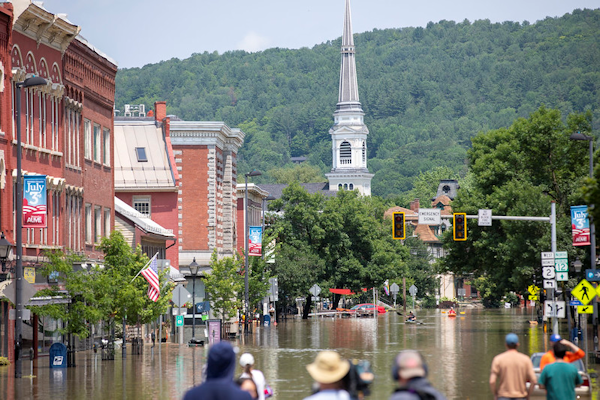SEJournal Online is the digital news magazine of the Society of Environmental Journalists. Learn more about SEJournal Online, including submission, subscription and advertising information.
 |
 |
| Flooding on main street in Montpelier, Vermont, July 11, 2023. Inland flooding has been responsible for more than half the deaths associated with U.S. tropical cyclones over the last three decades. Photo: U.S. Army National Guard/Sgt. Denis Nunez via Flickr Creative Commons (CC by 2.0). |
TipSheet: Dangerous Inland Flooding in Reporters’ Forecast
By Joseph A. Davis
The Vermont floods of July 2023 are a reminder that inland flooding is a significant environmental threat — and will become more so as climate heating worsens.
Environmental journalists may want to check into the possibility that such floods can occur in their own local area. There is a lot that communities, and reporters, can do to prepare for (or simply survive) floods.
Hurricanes often cause inland
flooding, sometimes miles away
from the coast and days after landfall.
To a certain extent, the news media is conditioned to prepare for such events by the experience of covering hurricanes, which are typically a regional or national story. Coastal cities worry about storm surge. But hurricanes often cause inland flooding, too, sometimes miles away from the coast and days after landfall.
Terminology should not get in the way. You may hear other terms such as flash flooding, river flooding, urban flooding, etc. The exact pattern depends on widely varying topography and infrastructure.
The key to such catastrophes is that they are caused by high rainfall or snowmelt, so high and fast that the water overwhelms existing drainage systems.
Why it matters
Floods kill people, destroy their homes and even their livelihoods.
 |
One fact worth contemplating: “In the last 30 years, inland flooding has been responsible for more than half the deaths associated with tropical cyclones in the United States.” So says Ed Rappaport, deputy director of the National Hurricane Center.
Floods have been harming people for many years — and human flood-control efforts have been trying to limit the damage almost as long.
You can investigate flooding history in many places, including on this U.S. Geological Survey page. A lot of the backstory was also well told in a July 11 New York Times piece (may require subscription) by Christopher Flavelle and Rick Rojas.
It’s worth noting that flood control efforts in the U.S. have gone on for many years — but that other human activities (such as paving over natural areas) have, all the while, been making flooding worse.
Story ideas
- Look in news archives for records of past flooding events in your area. Where did they happen? What infrastructure was involved?
- Follow the major drainage streams, rivers and storm drains in your area. Are there bottlenecks? Culverts? Bridges?
- Talk to the people who engineer roads, bridges, etc., in your area. Where do they think future flooding problems could arise?
- Talk to people at your local offices of the National Weather Service. Ask them what flood possibilities worry them.
- What will happen if your local rivers overflow their banks? Are there flood plains? How big? What structures are in the flood plains?
- Are there dams or other water control structures in your area? What role would they play in a flood — upstream or downstream? Can they limit flooding? What happens when reservoirs fill up and overflow?
- What are local zoning laws and rules about building in flood plains? Is your community eligible for the National Flood Insurance Program?
- Are there drinking water or sewage treatment plants in places vulnerable to flooding? What are their contingency plans for floods?
- What Superfund hazardous waste sites are located in your flood area? What about nonSuperfund hazardous waste sites? How vulnerable are they to floods?
Reporting resources
- National Weather Service: In addition to local offices, the NWS has other offices that focus on flooding issues. Check out the Advanced Hydrologic Prediction Service, for instance, which sheds light on the chances of flooding.
- National Oceanic and Atmospheric Administration: NOAA maintains comprehensive historical data about rainfall. Start with its Climate Data Online resource.
- National Hurricane Center: Not only does the NHC offer hour-by-hour hurricane predictions but it offers storm surge predictions and maps.
- Federal Emergency Management Agency: FEMA responds to floods, but also runs the National Flood Insurance Program. It makes widely used flood maps.
- U.S. Geological Survey: The USGS maintains an excellent network of streamflow gauges that not only measure floods but also offer historical streamflow data.
- University hydrologists: Check universities in your region for hydrologists and other scientists who may offer insight into your local situation.
[Editor’s Note: Check out our past flooding coverage, including TipSheets on extreme rainfall, a checklist for flood readiness, flood-resistant building construction, building in flood plains, the public health threat of combined sewer overflows and how extreme weather amplifies hazardous waste threats. Also see Reporter’s Toolboxes on mapping flood risk, understanding storm surge maps and using data sources to track climate-driven mayhem at Superfund sites. And check out a book author interview on the history of rain and a feature on the inequities of flooding. Finally, get extreme rain and flooding headlines from EJToday.]
Joseph A. Davis is a freelance writer/editor in Washington, D.C. who has been writing about the environment since 1976. He writes SEJournal Online's TipSheet, Reporter's Toolbox and Issue Backgrounder, and curates SEJ's weekday news headlines service EJToday and @EJTodayNews. Davis also directs SEJ's Freedom of Information Project and writes the WatchDog opinion column.
* From the weekly news magazine SEJournal Online, Vol. 8, No. 28. Content from each new issue of SEJournal Online is available to the public via the SEJournal Online main page. Subscribe to the e-newsletter here. And see past issues of the SEJournal archived here.












 Advertisement
Advertisement 



